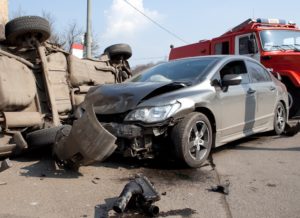Truck Accidents and Liability Issues – Who Pays
Texas truck accident cases can seem very overwhelming because there is so much confusion over who is liable. 
Is it the truck driver? The truck driver’s employer? Or some third party you are not even aware of?
Our experienced Texas injury attorneys can help you identify the responsible parties and prove your case.
Blood v. VH-1 Music First is a case arising from a car accident caused by a commercial truck. Dennis Hernandez (Hernandez) was a commercial truck driver for MTV Networks. While he was traveling northbound on I-57 in Illinois he approached traffic. In an attempt to avoid getting stuck in the traffic jam, Hernandez crossed the center median of the highway to get onto I-57 northbound. This u-turn on the highway caused a severe accident that left a four to five mile traffic jam starting where Hernandez made the u-turn causing the severe three car accident.
Four hours after the accident, traffic was still jammed because of the accident caused by the driver. Brothers Paul and David Blood (plaintiffs) were driving on I-57 in their vehicle when they approached the beginning of the traffic jam. Behind the blood car a T.E.A.M Logistics (Logistics) truck driven by Milinko Cukovic (Cukovic) came and smashed into the pack of the plaintiff’s car. This impact left David Blood seriously injured and Paul Blood deceased.
The Blood family filed personal injury lawsuits against Cukovic, and T.E.A.M Logistics. Logistics removed the case to federal court and entered a third-party complaint against Hernandez, MTV Networks and VH-1 Music First (Hernandez defendants). Logistics argued that because of the negligence of the Hernandez defendants which caused the first accident, the second accident occurred. The plaintiffs then added the Hernandez defendants in an amended complaint.
In order to prove a case for negligence, the plaintiff must prove by a preponderance of the evidence the four elements of negligence. The four elements of negligence are: the defendant had a specific duty of care; the defendant breached this duty of care; the defendant’s breach was the actual and proximate cause of the plaintiff’s injuries; and there are damages. 
Upon hearing the case, the district court entered summary judgment for the Hernandez defendants. This district court found that the Hernandez defendants were not the proximate cause of the injuries the plaintiff’s sustained. The plaintiff’s appealed this case to the circuit court.
This court first analyzed the validity of the lower courts summary judgment. The only time summary judgment is appropriate is where the moving party shows the court that there is no dispute as to the material facts of the case. Therefore, where there is a factual dispute it is improper for the court to grant summary judgment. A factual dispute is where a reasonable jury hearing the case could decide for either party.
The court in this case acknowledged that it is undisputed that Hernandez had a duty and that this duty was breached by Hernandez. However, to prove a case for negligence the plaintiff must show causation. Therefore, to establish if there was a factual dispute in this case, the court must examine the requirements of proximate cause.
To prove proximate cause the plaintiff must prove that the defendant’s breach of duty was a substantial factor to the injuries the plaintiff suffered. Next, plaintiff must show that a reasonably prudent person would be able to foresee that as a result of their action, the plaintiff could sustain the type of injuries sustained.
Because plaintiffs could not show that Hernandez could have foreseen a car accident four hours after the time that he made the illegal u-turn, this court affirmed the summary judgment of the district court. Plaintiffs were therefore unable to collect damages from the Hernandez defendants. For more information visit this website
Leave a Reply
You must be logged in to post a comment.